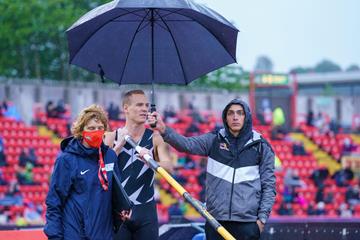 Countdown
Countdown
 Countdown
Countdown
The pole vault is a track and field event in which an athlete vaults over a 4.5-metre long horizontal bar. The vaulter sprints down a runway, plants a long, flexible pole (usually made of carbon fibre or fibreglass) against a ‘stop board’ at the back of a recessed metal box sited centrally at the base of the uprights. They then launch themselves into the air, seeking to clear the greatest height without knocking the bar to the ground.
The history of the pole vault began in Ancient Greece, where competitors aimed to vault the furthest distance
The origins of modern pole vaulting can be traced to Lancashire in England, where the first height-based competition was held in 1843
The format was adopted by a gymnastics association in Germany in the 1850s
The earliest contests used ash or hickory poles with iron spikes
The first recorded use of bamboo poles occurred in 1857
Steel poles were introduced during the 1940s
Flexible fibreglass and carbon fibre were widely used from the late 1950s onwards
The men’s pole vault has been contested at every modern Olympics – the US won every title between 1896 and 1968 (with the exception of the intercalated 1906 Games)
Women’s pole vault made its Olympic debut in 2000, when USA’s Stacy Dragila won the gold
The first official women’s pole vault world record was set by Sun Caiyun (China) in 1992. Her 4.05m jump was recognised by the International Associations of Athletics Federations (IAAF) in 1994.
However, the history of women’s pole vault predates Caiyun’s achievement. The first pre-IAAF record was claimed by Ruth Spencer (United States) who vaulted 1.44m in 1910. One year later, Spencer set 10 records, progressing from 1.47m to 1.72m in a single day.
Several other American vaulters have set multiple records, including Mildred Carl, Irene Spieker and Jana Edwards. Carl was the first to jump 2.00m (1915), Spieker broke through the three-metre-barrier (3.05m in 1979), and Edwards surpassed 3.50m (3.59m in 1983).
The final pre-IAAF records were set by Zhang Chunzen (China) in 1991. She was the first woman to clear 4.00m.
From here, women’s pole vault world record progression was dominated by four athletes: Daniela Bártová (Czech Republic), Emma George (Australia), Stacy Dragila (United States) and Yelena Isinbayeva (Russia). George was the first woman to reach 4.50m (1997), while Isinbayeva revolutionised the sport with her 5.00m performance (2005). Four years later, Isinbayeva set the current pole vault world record of 5.06m.
The first official men’s pole vault world record was recognised by the International Association of Athletics Federations in 1912. It was set by Marc Wright (United States). In setting the record, he also became the first pole vaulter to clear four metres (4.02m).
From here, the men’s pole vault world record progression continued at a rapid pace. Milestones were set by some of the USA’s most notable athletes, including Cornelius Warmerdam and Brian Sternberg. Warmerdam’s 4.77m record was undefeated from 1942 until 1957, while Sternberg was the first man to clear 5.00m (1963).
Outside of the US, Kjell Isaksson (Sweden) was the first to surpass 5.50m (5.51m in 1972). He was followed by Thierry Vigneron (France) who reached 5.80m in 1981. Next came the most prolific record-setter of all time: Sergey Bubka (Soviet Union and Ukraine). He set 14 consecutive records between 1984 and 1994, starting at 5.94m and finishing with 6.14m.
Today, the men’s pole vault world record is held by Armand ‘Mondo’ Duplantis (Sweden). He set his eighth successive record with a jump of 6.24m in 2024.
Pole vaulting is an event that demands speed, power, strength, agility and gymnastic skills.
Historically, the United States has been the most successful pole vaulting nation. The US won 16 consecutive Olympic gold medals between 1896 and 1968 (not including the 1906 intercalated Games). Winners included the iconic Bob Richards, who was the first pole vaulter to win two Olympic gold medals (1952, 1956).
The country’s notable pole vault female athletes include Katie Moon. She won gold at the Olympics in 2021 as well as back-to-back world titles in 2022 and 2023. Similarly, Stacy Dragila made history when she became the first woman to claim Olympic gold in the pole vault at the 2000 Olympics.
Heading north, Shawn Barber was the first Canadian pole vaulter to win the World Championships (2015). Elsewhere, in recent years, two pole vaulters have pushed the boundaries of the sport: Yelena Isinbayeva (Russia) and Mondo Duplantis (Sweden).
Isinbayeva is widely regarded as the greatest female pole vaulter of all time. She set multiple world records, earned two Olympic gold medals (2004, 2008) and three world titles (2005, 2007, 2013). In men’s pole vaulting, Duplantis has redefined the sport. He is a two-time world outdoor (2022, 2023) and indoor (2022, 2024) champion, three-time Diamond League winner (2021, 2022, 2023) and an Olympic gold medallist (2021).
Added to this, in recent years, Molly Caudery (Great Britain) has taken the pole vault world by storm. Her highlights include the gold medal at the 2024 World Indoor Championships.

Pole vault is a high-adrenaline discipline. To excel, each athlete must master a range of skills. Here is a guide to the correct pole vault technique:
Before a competitor begins, they must utilise the correct pole vault grip. The vaulter holds the pole vertically, keeps one hand at their hip and places the other hand roughly 10cm in front of their chest, above elbow height.
The approach is the first part of the pole vault. The vaulter accelerates down the runway, building speed with a controlled, rhythmic sprint. As the athlete advances, they gradually lower the pole. They raise the rear hand above the waist; the other hand remains in position and controls the pole as it pivots.
The approach is typically completed in 10 to 20+ strides. The pole should be parallel to the ground three steps before take-off.
Take-off involves planting the pole against a ‘stop board’ at the back of a recessed metal box.
The vaulter lifts their arms above their head, extending their body and raising the pole vertically. They take off with the jump foot, drive the pole into the plant position and bring their drive knee (other foot) upwards.
Maintaining a strong grip on the pole, the vaulter pushes their arms back and leads with the chest. Keeping their jumping leg extended and the other leg bent at the knee, they swing their legs upwards until parallel with the floor.
Next, the vaulter moves into the extension phase. This begins when the pole has reached its maximum bend. During this part of the technique, the vaulter thrusts their hips forward and straightens their legs. With their body outstretched, they push their feet above their head and drive towards the sky.
From this vertical position, the vaulter executes the turn. After achieving the maximum height, they release the pole and rotate their body 180 degrees.
The fly away is the final phase of the pole vault technique. The vaulter pikes over the bar and falls backwards on to the mat.
At major championships, the format for the pole vault is usually a qualification round followed by a final. Here are the main pole vault rules that are used in competitions:
Each competitor has a maximum of three attempts per height
A jump is considered successful if the athlete clears the bar without dislodging it
The height of the bar is raised in increments after each round of trials
Athletes may ‘pass’ an attempt and progress to a higher height without clearing the current one
Three consecutive failures at the same height, or combination of heights, leads to eliminationAthletes must initiate their attempt within a set time limit
Foul attempts include failing to clear the bar and knocking the bar from the supports
If the pole breaks, this counts as an equipment failure, not a foul, and the athlete is awarded a replacement trial
The winner of the pole vault is the athlete who successfully clears the highest height. In the event of a tie, the athlete with the fewest failures at that height is declared the winner.
If the tie remains, the winner is the vaulter who has produced the fewest failures throughout the entire competition. If the tied athletes remain tied, the winner is decided via a jump-off. Each jumper has one attempt per height, and the bar is lowered (if the athletes fail) or raised (if the athletes succeed) until only one jumper succeeds at one height. If the relevant athletes at any stage decide not to jump further, the tie remains.
Volzing is an illegal pole vaulting technique in which the vaulter steadies or pushes the bar back on to the pegs if it starts to fall. It was named after the US pole vaulter David Volz, who popularised the method.
The technique allowed athletes to save failed attempts. However, it was banned by the IAAF in 1983. This decision was made to maintain the integrity and fairness of the sport, ensuring vaulters relied on their skills rather than manipulating equipment.
The pole vault box, also known as the planting box, is a metal box in which the athletes must plant their pole when jumping. The box is located centrally at the base of the uprights. The vaulter initiates their jump by jamming the pole against the stop board.
In international competition, rules state that the pole vault box must measure: 1.08m in length, 0.6m in width (at the front), 0.15m wide (at the inside back) and 0.20m in depth.
The length of a pole used in the pole vault normally ranges between 4 and 5.20 metres. The length of the pole is not fixed, and it varies depending upon the skill, speed, height and preferences of the individual vaulter.
The weight of a pole varies depending on the length of the pole, the materials used and the weight of the athlete. Poles are graded using weight ratings and athletes should compete on a pole that has been designed for their weight.
Modern poles are commonly made using lightweight materials such as fibreglass or carbon fibre. In addition to being light, these materials are also robust, providing the flexibility and strength required for vaulting.
 SWE
SWE
 GRE
GRE
 AUS
AUS
 USA
USA
 NED
NED
 FRA
FRA
 FRA
FRA
 TUR
TUR
 USA
USA
 NOR
NOR
 USA
USA
 USA
USA
 SLO
SLO
 SUI
SUI
 GBR
GBR
 FRA
FRA
 CZE
CZE
 USA
USA
 NZL
NZL
 USA
USA







